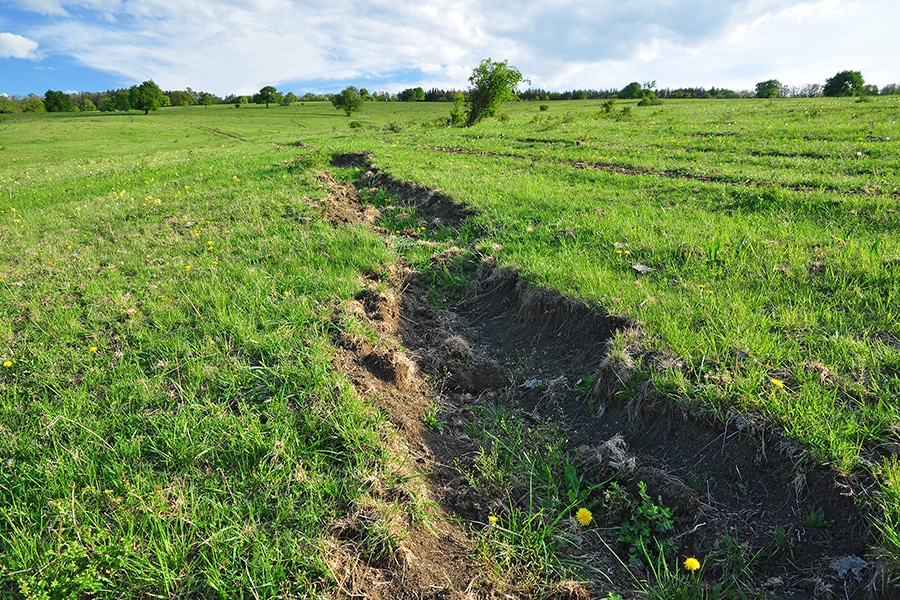Soil erosion occurs when the top layer of soil is swept away from the land by weather such as wind or rainfall. This natural process can be amplified in pastures when land is overly exposed or stressed, or if your pasture is located in an area that experiences frequent rainstorms. When soil is carried off-site by erosion, it can fill nearby creeks or streams, and potentially damage not only your pastures but water quality as well.
Erosion in pastures can be a headache to manage. Preventing erosion is incredibly important in good management and maintaining a healthy pasture. Mismanagement of your pasture that leads to increased erosion can create potential problems down the line. To better ensure that you can avoid some of these issues, we’re here to walk you through some helpful prevention techniques.
Causes of Soil Erosion
Soil erosion can happen naturally, or it can be a result of mismanaging your pastures. Things like overgrazing, improper use of sacrifice areas, not rotating pasture spaces, weeds, and more can all be causes of erosion. Erosion tends to occur when a pasture lacks appropriate plant cover to hold the soil in place during inclement weather events or even just normal rainfall. Managing your pasture with rotational grazing techniques and use of sacrifice areas can be a great way to ensure a strong root system and ample grasses for your livestock.
Erosion can also be caused simply by having your pasture on a slope. While it is likely not a good option to move your pasture, you can counteract the negative impacts of erosion by placing a natural foliage barrier towards the bottom of your slope. Additionally, planting forage plants that are hardy and known for forming strong root systems can help ensure surface soil stability, reducing the chance of erosion.
While weeds are a normal part of any ecosystem, they tend to not establish strong root systems, making them easily washed away in the instance of a heavier rain. Removing weeds can further help your intended forage plants grow while also reducing erosion. Keep in mind that the easiest way to maintain topsoil is to have a strong layer of vegetation protecting the soil below. If your pasture is not experiencing severe erosion, the fix could be as simple as adding some strong grasses to your grazing spaces.
Effects of Soil Erosion
Erosion can be a very slow and gradual process, or it can happen severely overnight. Regardless of how it happens, it’s important to be aware of the effects it can have on your pasture.
Soil erosion can create many problems in a pasture, whether it is severe or minor. When soil is swept away, it strips away many vital nutrients from the land. The surface layer of soil locks in nutrients that help both the plants in your pastures and the grazing animals.
Erosion can also negatively impact nearby water sources through manure pollution, excessive nutrients, and more. There are ways to counteract negative impacts of nearby surface waters, such as planting a natural dike near the bottom of your pasture if it is sloped.
Prevention Techniques
Pasture rotation and designating sacrifice areas are great ways to prevent soil erosion in your pastures. By rotating which pastures are in use, you allow grasses and root systems to recuperate and maintain strong roots. Simply giving grasses a few weeks off will allow them to remain strong and hearty. Not only will this aid in preventing erosion, but it will also ensure that your land is not experiencing too much stress.
To further prevent erosion, you should also establish sacrifice areas that can be used by your livestock in the instance of heavy rain, or when forage areas need a break. A sacrifice area, such as a paddock, with proper footing can help maintain a healthy pasture for longer by allowing soil and grasses to rest without the constant damage from animal hooves. Proper footing will ensure that soil in the paddock area does not erode, which could cause problems in your pasture. For more information on paddock footing, check out our great options here.
If you notice that one area of your pasture is experiencing more erosion than others, maybe by a gate or a small corner section, one solution is to use a ground stabilization tool like geocells. Geocells are an interlocking grid of durable cells that form a strong barrier against erosion. When used in conjunction with planting vegetation, they are incredibly effective at slowing erosion. For more information on geocell use for ground stabilization, check out our page here.
Lastly, removing weeds is a simple way to ensure strong root systems that can fight off erosion. If your pasture struggles with too many weeds, try mowing or using physical removal methods. This will help the beneficial grasses grow, while removing weak roots that don’t stand a chance against heavier rainfall.
Solutions for Easy Pasture Management
At Performance Footing, we provide the products you need for establishing and maintaining your paddocks with ease. Cutting down on erosion should be simple and stress-free. Give us a call today at 877-835-0878 to discuss how we can support your pasture management efforts.
